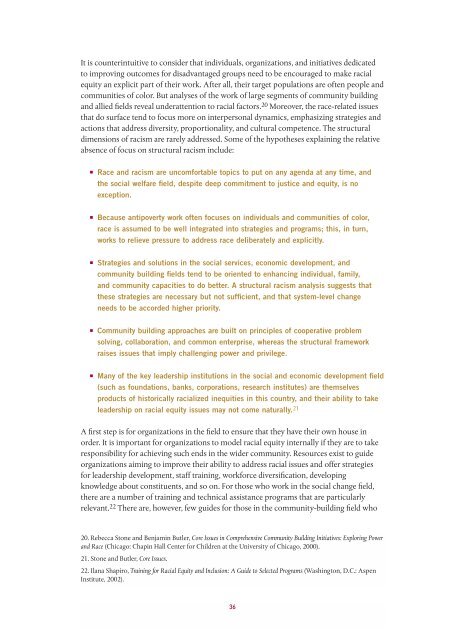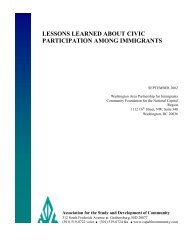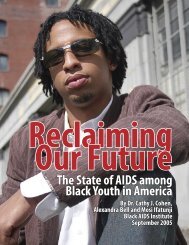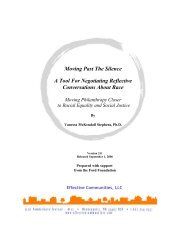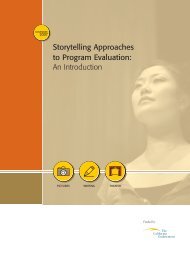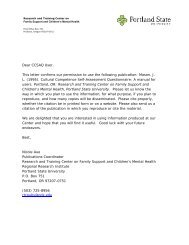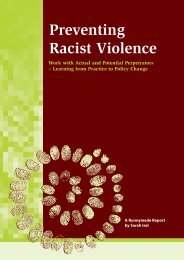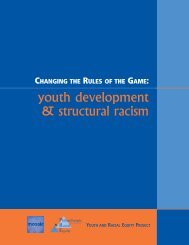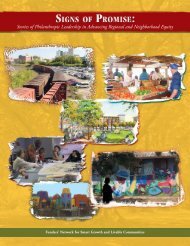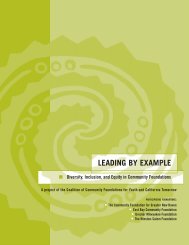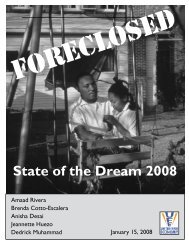Structural Racism and Community Building - The Aspen Institute
Structural Racism and Community Building - The Aspen Institute
Structural Racism and Community Building - The Aspen Institute
You also want an ePaper? Increase the reach of your titles
YUMPU automatically turns print PDFs into web optimized ePapers that Google loves.
It is counterintuitive to consider that individuals, organizations, <strong>and</strong> initiatives dedicated<br />
to improving outcomes for disadvantaged groups need to be encouraged to make racial<br />
equity an explicit part of their work. After all, their target populations are often people <strong>and</strong><br />
communities of color. But analyses of the work of large segments of community building<br />
<strong>and</strong> allied fields reveal underattention to racial factors. 20 Moreover, the race-related issues<br />
that do surface tend to focus more on interpersonal dynamics, emphasizing strategies <strong>and</strong><br />
actions that address diversity, proportionality, <strong>and</strong> cultural competence. <strong>The</strong> structural<br />
dimensions of racism are rarely addressed. Some of the hypotheses explaining the relative<br />
absence of focus on structural racism include:<br />
e Race <strong>and</strong> racism are uncomfortable topics to put on any agenda at any time, <strong>and</strong><br />
the social welfare field, despite deep commitment to justice <strong>and</strong> equity, is no<br />
exception.<br />
e Because antipoverty work often focuses on individuals <strong>and</strong> communities of color,<br />
race is assumed to be well integrated into strategies <strong>and</strong> programs; this, in turn,<br />
works to relieve pressure to address race deliberately <strong>and</strong> explicitly.<br />
e Strategies <strong>and</strong> solutions in the social services, economic development, <strong>and</strong><br />
community building fields tend to be oriented to enhancing individual, family,<br />
<strong>and</strong> community capacities to do better. A structural racism analysis suggests that<br />
these strategies are necessary but not sufficient, <strong>and</strong> that system-level change<br />
needs to be accorded higher priority.<br />
e <strong>Community</strong> building approaches are built on principles of cooperative problem<br />
solving, collaboration, <strong>and</strong> common enterprise, whereas the structural framework<br />
raises issues that imply challenging power <strong>and</strong> privilege.<br />
e Many of the key leadership institutions in the social <strong>and</strong> economic development field<br />
(such as foundations, banks, corporations, research institutes) are themselves<br />
products of historically racialized inequities in this country, <strong>and</strong> their ability to take<br />
leadership on racial equity issues may not come naturally. 21<br />
A first step is for organizations in the field to ensure that they have their own house in<br />
order. It is important for organizations to model racial equity internally if they are to take<br />
responsibility for achieving such ends in the wider community. Resources exist to guide<br />
organizations aiming to improve their ability to address racial issues <strong>and</strong> offer strategies<br />
for leadership development, staff training, workforce diversification, developing<br />
knowledge about constituents, <strong>and</strong> so on. For those who work in the social change field,<br />
there are a number of training <strong>and</strong> technical assistance programs that are particularly<br />
relevant. 22 <strong>The</strong>re are, however, few guides for those in the community-building field who<br />
20. Rebecca Stone <strong>and</strong> Benjamin Butler, Core Issues in Comprehensive <strong>Community</strong> <strong>Building</strong> Initiatives: Exploring Power<br />
<strong>and</strong> Race (Chicago: Chapin Hall Center for Children at the University of Chicago, 2000).<br />
21. Stone <strong>and</strong> Butler, Core Issues.<br />
22. Ilana Shapiro, Training for Racial Equity <strong>and</strong> Inclusion: A Guide to Selected Programs (Washington, D.C.: <strong>Aspen</strong><br />
<strong>Institute</strong>, 2002).<br />
36


